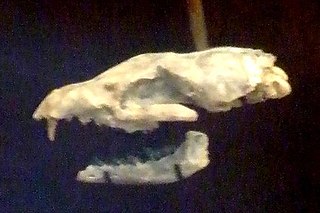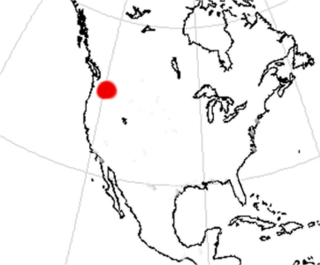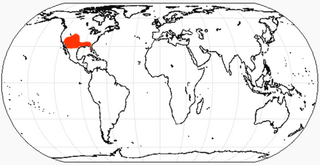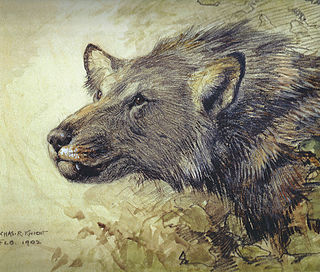
Canidae is a biological family of dog-like carnivorans, colloquially referred to as dogs and constitutes a clade. A member of this family is also called a canid. There are three subfamilies found within the canid family, which are the extinct Borophaginae and Hesperocyoninae, and the extant Caninae. The Caninae are known as canines, and include domestic dogs, wolves, foxes, coyotes and other extant and extinct species.

Borophagus is an extinct genus of the subfamily Borophaginae, a group of canids endemic to North America from the Middle Miocene epoch through the Late Pliocene epoch 12—2 Mya.

Aelurodon is an extinct canine genus of the subfamily Borophaginae which lived from the Barstovian land mammal age of the middle Miocene to the late Miocene epoch. Aelurodon existed for approximately 10.7 million years.

Epicyon is a large, extinct, canid genus of the subfamily Borophaginae, native to North America. Epicyon existed for about 15 million years from the Hemingfordian age of the Early Miocene to the Hemphillian of the Late Miocene.

The extinct Hesperocyoninae are one of three subfamilies found within the canid family. The other two canid subfamilies are the extinct Borophaginae and extant Caninae.

Archaeocyon is an extinct genus of the Borophaginae subfamily of canids native to North America. It lived during the Oligocene epoch 32-24 Ma., existing for approximately 8 million years. Species of Archaeocyon are among the earliest known borophagines, although a species of Otarocyon has a slightly earlier first appearance. Fossils have been found across the northern Great Plains and along the west coast of North America.

Oxetocyon is an extinct monospecific genus of the Borophaginae subfamily of canids native to North America. It lived during the Early Oligocene epoch, existing for approximately 2.5 million years. Fossils have been found in Nebraska and South Dakota.

Cynarctus is an extinct genus of the Borophaginae subfamily of canids native to North America. The genus was first founded by W. D. Matthew in 1901, based from a pair of lower jaws, Cynarctus saxitilis, found in the Pawnee Creek Beds of Colorado. It lived during the Middle to Late Miocene 16.0—10.3 mya, existing for approximately 5.7 million years. Fossils have been uncovered in Colorado, California, Maryland, western Nebraska, and Texas. It was likely an omnivore, and lacked the bone-cracking adaptations found in some later borophagines. Newer findings have proved the genus to be described as a large dog-like raccoon, a result from combining characteristics from Canidae with Procyonidae.

Rhizocyon is an early member of the subfamily Borophaginae, an extinct subgroup of canids that were endemic to western North America during the Oligocene epoch, living from ~31—24.5 Ma., existing for approximately 6.5 million years.

Cormocyon is an extinct genus of borophagine canid native to North America. It lived from the Oligocene to the Early Miocene, 30.8—20.6 Mya, existing for about 10.2 million years. It is regarded as a primitive, transitional member of the Borophagini tribe.
Metatomarctus is an extinct genus of the Borophaginae subfamily of canids native to North America. It lived during the Early to Middle Miocene, 23—16 Mya, existing for approximately 7 million years It was an intermediate-size canid, and more predaceous than earlier borophagines.

Paratomarctus is an extinct monospecific genus of the Borophaginae subfamily of canids native to North America. It lived from the Middle to Late Miocene, 16.3—5.3 mya, existing for approximately 11 million years. It was about the size of a coyote, and was probably a generalised predator, without the specialised adaptations of most later borophagines.

Carpocyon is an extinct genus of the Borophaginae subfamily of canids native to North America. It lived from the Middle to the Late Miocene, 13.6 to 5.3 Ma Mya, existing for approximately 16.5 million years. The four species in the genus varied in size, with the largest being about the size of a wolf; all had relatively small teeth, suggesting a diet that was more omnivorous than that of other contemporary borophagines.
Protomarctus is an extinct monospecific genus of the Borophaginae subfamily of canids native to North America. They lived during the Middle Miocene 16.0—13.6 Mya, existing for approximately 2.4 million years. It was an intermediate-size canid, and more predaceous than earlier borophagines.
Paracynarctus is an extinct genus of the Borophaginae subfamily of canids native to North America. It lived from the Early Miocene to Middle Miocene 16.0—13.6 Ma, existing for approximately 2.4 million years. It was likely an omnivore, and lacked the bone-cracking adaptations found in some later borophagines.
Borophagina is a subtribe of the Borophaginae, a group of extinct canids. They inhabited much of North America from the Early Miocene to the Zanclean stage of the Pliocene, 20.6—3.6 Mya, and existed for approximately 17 million years.

Tephrocyon is an extinct genus of the Borophaginae subfamily of canids native to North America. They lived during the Barstovian stage of the Middle Miocene 16.3—13.6 million years ago, existing for roughly 2.7 million years. It is a rarely found genus, with fossil deposits only occurring in western Nebraska, Wyoming, eastern Oregon, New Mexico, and north Florida. It was an intermediate-sized canid, and more predatory than earlier borophagines.

Borophagus hilli is an extinct species of the genus Borophagus of the subfamily Borophaginae, a group of canids endemic to North America from the Late Miocene until the Pliocene.

Borophagus diversidens is an extinct species of the genus Borophagus of the subfamily Borophaginae, a group of canids endemic to North America from the late Miocene epoch through the Pliocene epoch 4.9—1.8 Ma.

Borophagus secundus is an extinct species of the genus Borophagus of the subfamily Borophaginae, a group of canids endemic to North America from the Early Miocene epoch through the Late Miocene epoch. Borophagus secundus existed for approximately 17.7 million years.














